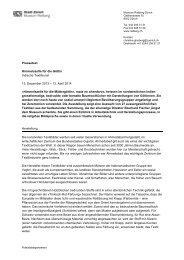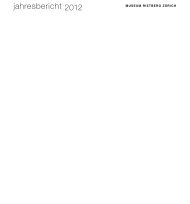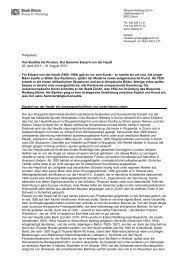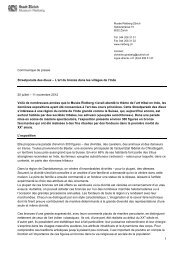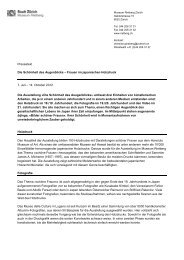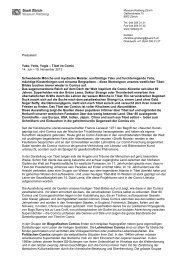1.1 eduard von der heydt - Museum Rietberg
1.1 eduard von der heydt - Museum Rietberg
1.1 eduard von der heydt - Museum Rietberg
You also want an ePaper? Increase the reach of your titles
YUMPU automatically turns print PDFs into web optimized ePapers that Google loves.
3.2<br />
<strong>von</strong><br />
<strong>der</strong> <strong>heydt</strong><br />
als bankier<br />
Eduard <strong>von</strong> <strong>der</strong> Heydt hat im Lauf seines<br />
Lebens vier Privatbanken gegründet. In <strong>der</strong> Schweiz jedoch,<br />
wo er seit 1926 auf dem Monte Verità ebenfalls einen Wohnsitz<br />
hatte, führte er nie eine eigene Bank. Hier wickelte er<br />
seine Geschäfte über Vermögensgesellschaften und Konten<br />
bei an<strong>der</strong>n Banken ab. Von <strong>der</strong> Heydt tätigte zwar durchaus<br />
ertragreiche Finanzgeschäfte, war aber keineswegs <strong>der</strong> erfolgreiche<br />
Bankier, für den er immer gehalten wurde. Auch<br />
war er nicht, obwohl er dies selbst kolportierte, <strong>der</strong> Bankier<br />
Wilhelms II., des deutschen Kaisers, <strong>der</strong> ab 1918 in Holland<br />
im Exil lebte und den er gut kannte.<br />
Von <strong>der</strong> Heydts erste Bank (London 1910–1914)<br />
wurde im Ersten Weltkrieg beschlagnahmt, die zweite (Amsterdam<br />
1920–1924) musste er ökonomisch bedingt aufgeben,<br />
die dritte (Zandvoort 1924–1942) kriegsbedingt liquidieren,<br />
und die vierte, diejenige in Berlin (1925–1927), konnte<br />
nur dank <strong>der</strong> Übernahme durch die Thyssen-Brü<strong>der</strong> gerettet<br />
werden; <strong>von</strong> <strong>der</strong> Heydt verblieb aber bis 1943 im Aufsichtsrat.<br />
Diese Bank, die nach 1930 August Thyssen-Bank AG hiess,<br />
stand dem Nationalsozialismus nahe und pflegte Beziehungen<br />
zum militärischen Nachrichtendienst («Abwehr»). Fritz<br />
Thyssen war zu Beginn <strong>der</strong> 1930er-Jahre ein grosser För<strong>der</strong>er<br />
Adolf Hitlers. Sein Bru<strong>der</strong> Heinrich Thyssen-Bornemisza,<br />
<strong>der</strong> Haupteigentümer <strong>der</strong> Bank, lebte seit 1932 in Lugano.<br />
Als Fritz Thyssen – in Ungnade gefallen – 1939<br />
aus Deutschland floh, lag es an <strong>von</strong> <strong>der</strong> Heydt, die Bank zu<br />
repräsentieren. So führte er Finanztransaktionen für die<br />
Abwehr aus, die er anfangs über seine Bank in Holland,<br />
später über die Schweizerische Bankgesellschaft in Locarno<br />
abwickelte. Es handelte sich unter an<strong>der</strong>em um Zahlungen<br />
an deutsche Agenten in Mexiko. Nachdem er im Oktober 1943<br />
<strong>von</strong> <strong>der</strong> Schweizerischen Bundespolizei aufgrund <strong>von</strong> Hinweisen<br />
<strong>der</strong> amerikanischen Behörde verhört worden war,<br />
trat er im November aus dem Aufsichtsrat <strong>der</strong> Thyssen-Bank<br />
zurück.<br />
3.2<br />
<strong>von</strong> <strong>der</strong> <strong>heydt</strong><br />
as banker<br />
During his lifetime, Eduard <strong>von</strong> <strong>der</strong> Heydt established<br />
four private banks. In Switzerland, however, where<br />
from 1926 he also had a home on Monte Verità, he never had<br />
his own bank. Here, he managed his business affairs through<br />
trusts and accounts with other banks. Although some of <strong>von</strong><br />
<strong>der</strong> Heydt’s business activities were profitable, he was not<br />
the successful banker that he is often portrayed as being. He<br />
was also not – despite the fact that he himself spread the<br />
story – the banker of Wilhelm II, the German emperor who<br />
from 1918 was in exile in the Netherlands and whom he knew<br />
well.<br />
Von <strong>der</strong> Heydt’s first bank (London 1910–1914)<br />
was confiscated during the First World War, the second<br />
(Amsterdam 1920–1924) was not economically viable and<br />
had to be closed, the third (Zandvoort 1924–1942) had to<br />
be liquidated because of the war, and the fourth, in Berlin<br />
(1925–1928), could only be saved thanks to the takeover by<br />
the brothers Thyssen; but <strong>von</strong> <strong>der</strong> Heydt remained on the<br />
board until 1943. This bank, which from 1930 was called<br />
August Thyssen-Bank AG, was close to Nazism and maintained<br />
relations with military intelligence (the “Abwehr”).<br />
From the beginning of the 1930s, Fritz Thyssen was an<br />
important supporter of Adolf Hitler. His brother Heinrich<br />
Thyssen-Bornemisza, the main owner of the bank, lived in<br />
Lugano from 1932.<br />
When Fritz Thyssen – having fallen from favour<br />
– had to flee Germany in 1939, it fell to <strong>von</strong> <strong>der</strong> Heydt<br />
to represent the bank. He handled financial transactions for<br />
the Abwehr which to begin with he did through his bank in the<br />
Netherlands and later through the Union Bank of Switzerland<br />
in Locarno. The transactions included payments to German<br />
agents in Mexico. After he had been questioned in October<br />
1943 by the Swiss fe<strong>der</strong>al police because of tip-offs from the<br />
US administration, he left the board of the Thyssen-Bank in<br />
November of that year.<br />
3.2<br />
le banquier<br />
<strong>von</strong> <strong>der</strong> <strong>heydt</strong><br />
Eduard <strong>von</strong> <strong>der</strong> Heydt a créé, au cours de sa vie,<br />
quatre banques privées. En Suisse, toutefois, où il possédait<br />
également un domicile au Monte Verità depuis 1926, il n’a jamais<br />
dirigé de banque en son nom propre. Ses transactions<br />
étaient exécutées par des sociétés financières ou par le biais<br />
de comptes auprès d’autres banques. Von <strong>der</strong> Heydt réalisait,<br />
certes, des opérations qui rapportaient beaucoup d’argent,<br />
mais il n’était nullement le banquier couronné de succès que<br />
l’on aurait pu croire. Il n’était pas non plus, malgré la rumeur<br />
qu’il faisait courir lui-même, le banquier de l’empereur allemand<br />
Guillaume II, lequel vécut exilé en Hollande à partir de<br />
1918 et qu’il connaissait bien.<br />
La première banque d’Eduard <strong>von</strong> <strong>der</strong> Heydt<br />
(Londres, 1910–1914) fut saisie pendant la Première Guerre<br />
mondiale; quant à la deuxième (Amsterdam, 1920–1924), il<br />
dut s’en séparer pour des raisons économiques; la troisième<br />
(Zandvoort, 1924–1942) fut liquidée à cause de la guerre, et<br />
la quatrième, celle de Berlin (1925–1928) ne fut sauvée que<br />
grâce à l’intervention des frères Thyssen qui la rachetèrent;<br />
<strong>von</strong> <strong>der</strong> Heydt resta toutefois dans le Conseil de surveillance<br />
jusqu’en 1943. Cette banque, qui s’appela August Thyssen-<br />
Bank AG après 1930, était liée au national-socialisme et entretenait<br />
des relations avec le Service de renseignements<br />
militaires (la «défense»). Au début des années 1930, Fritz<br />
Thyssen soutenait généreusement Adolf Hitler. Son frère<br />
Heinrich Thyssen-Bornemisza, le principal propriétaire de la<br />
banque, vivait à Lugano depuis 1932.<br />
Lorsque, tombé en disgrâce, Fritz Thyssen fuit<br />
l’Allemagne en 1939, Eduard <strong>von</strong> <strong>der</strong> Heydt est chargé de représenter<br />
la banque. Il effectue alors des transactions financières<br />
pour le compte du Service de renseignements militaires<br />
par l’intermédiaire de sa banque en Hollande, puis, par<br />
le biais de l’Union de banques suisses à Locarno. Il s’agissait,<br />
entre autres, de versements à des agents allemands en poste<br />
au Mexique. Après avoir été interrogé par la Police fédérale<br />
suisse en octobre 1943, sur la base de renseignements fournis<br />
par les autorités américaines, il démissionnera du Conseil<br />
de surveillance un mois plus tard.<br />
Von <strong>der</strong> Heydt’s Bank AG, Berlin, 1928 (Sasha Stone)






